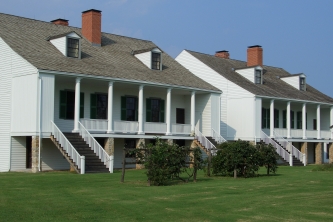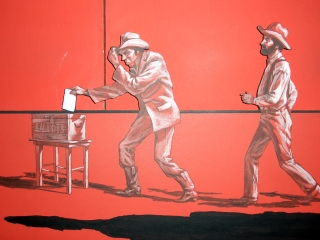NPS Website; Local Website
 WHAT IS IT?
WHAT IS IT?Partially restored and partially reconstructed U.S. Army Fort that played a role in the 1840’s Indian frontier, the 1848 Mexican War, 1850’s Bleeding Kansas and the Civil War.
BEAUTY (4/10)
Fort Scott looks more pompous that practical, more ostentatious than utilitarian. Its Greek-revival style buildings are painted wonderfully white, its pillars steadied by travertine supports. Exterior stairways promenade up to the second floor, the main floor, where breezy porches and green shutters suggest a comfortable domestic life.
A glistening seven-pillared white canopy tops the Fort’s interior well and looks mightily out-of-place on the Kansas frontier. A restored tallgrass prairie surrounds half of the Fort, serving as an unsuccessful buffer to the speeding cars on U.S. Route 69. The charming 19th Century structures of downtown Fort Scott surround the actual Fort’s other half. The town initially sprung up to serve the military’s needs and to this day maintains its delightful Victorian feel.
HISTORICAL INTEREST (4/10)
Troops stationed at Fort Scott were involved in a number of historic events but their role was never primary and the Fort’s connection sometimes tenuous at best. The Park brochure cites four historical occasions as important to the Park’s past: the Kearny Expedition, the Mexican War, Bleeding Kansas and the Civil War.
Col. Kearny’s dragoons, forerunners to the U.S. Cavalry, did march across the High Plains in 1845 and repeated the march to Santa Fe, during the Mexican War, in 1846. Kearny was headquartered not at Fort Scott, but at Fort Leavenworth. Companies from Fort Scott joined Kearny’s men in Mexico, just as they had during his expedition.
 Bleeding Kansas began in 1854 after the passage of Stephen Douglas’ Kansas-Nebraska Act. This law mandated popular sovereignty in the Kansas Territory, meaning that the Territory had a right to choose whether it would allow slavery. Floods of immigrants, both abolitionists and proslavery advocates, poured into the Territory resulting in two Constitutions, two governments, massacres committed by both sides, extreme bloodshed and absolute chaos.
Bleeding Kansas began in 1854 after the passage of Stephen Douglas’ Kansas-Nebraska Act. This law mandated popular sovereignty in the Kansas Territory, meaning that the Territory had a right to choose whether it would allow slavery. Floods of immigrants, both abolitionists and proslavery advocates, poured into the Territory resulting in two Constitutions, two governments, massacres committed by both sides, extreme bloodshed and absolute chaos.Most of the problems occurred well north of Fort Scott (we did not realize this before our visit). The Fort did not play that active a role in the drama, despite the rabid violence. Federal troops had actually abandoned the Fort in 1853 (bad timing, it seems) and did not return until 1857. Only rarely were troops dispatched to protect the local citizenry.
During the Civil War, Fort Scott served mainly as a supply depot.
CROWDS (6/10)
The only other people roaming the Fort Scott parade grounds at 9:00am were Park workers preparing for the weekend’s “Highlights in History” program. The Program involved costumed Rangers explaining frontier life at Fort Scott and occurred three times this summer. We are guessing that there was a time when the “Highlight in History” program was the daily norm rather than a special event.
EASE OF USE/ACCESS (2/5)
Fort Scott NHS is located in downtown Fort Scott, Kans, just west of the Missouri border. The town sits at the crossroads of U.S. Routes 69 (north-south) and 54 (east-west). Fort Scott is 90 miles south of Kansas City, Kans.; 60 miles north of Joplin, Mo. and 150 miles east of Wichita, Kans.
CONCESSIONS/BOOKSTORE (4/5)
The books selection, like the Site, is spread a little thin. You can still find many great and unique titles like Lincoln and Kansas; Jennison’s Jayhawkers; Kansas in the Sixties (the 1860’s) and the entire Covered Wagon Women series, diaries and letters from women traveling along various western trails. A trading post reproduction wall sells Union hats, bonnets, tin cups and miniature cannons.
 COSTS (3/5)
COSTS (3/5)Entry is $3 per person, free with the National Parks Pass.
RANGER/GUIDE TO TOURIST RATIO (1/5)
We saw people walking around the Site who did not look like tourists, but they were not wearing the familiar green uniform either. One Ranger is posted at the bookstore, collecting fees, but all of the exhibits are in different buildings, some located a good distance from the bookstore. If you have questions, you are out of luck.
TOURS/CLASSES (3/10)
The Park brochure lists eleven reconstructed or restored Fort Scott buildings that include exhibits, explaining either the broad history or military life. The Park also includes a nature walk through a restored tallgrass prairie (wear bug spray).
There is too much to see and do in too large a surface area. Our minds wandered…and we really like this stuff. You should start your visit with the Infantry Barracks Museum. The bottom floor shows a very old cartoon slide show that explains the Fort’s long history. “Enough about food storage, officer’s wives and horse stables,” we thought aloud, “what about Bleeding Kansas?”
We were going to have to wait. The Barracks Museums second floor did have a Bleeding Kansas exhibit, but the explanations were reduced to cartoon drawings and short sentences. Meanwhile you have the whole building to yourself. No one is there to elaborate or answer questions about the complex history.
The other buildings are also self-guided and each enjoys a unique set of confusions: since Fort Scott was involved in so many historical periods it is perpetually unclear what year and which historical theme each building represents. The panels offer little help. Our brains shut off after a few trips on the pilot-less whirlwind time machine.
 FUN (3/10)
FUN (3/10)Fort Scott NHS disappointed us. We anticipated an in-depth look at the fascinating Bleeding Kansas crises, the Kansas-Nebraska Act, relations with Missouri and the build up to the Civil War. Instead, the Fort was a mish-mash of many historical periods and themes with an emphasis on day-to-day military and cavalry life on the frontier.
WOULD WE RECOMMEND? (3/10)
A number of NPS Fort Sites tackle frontier military life, all with more geographic merit; Fort Scott was hardly a remote post as its bustling 19th Century-built downtown proves. Fort Scott NHS was not a bad place to visit; it just did not live up to our expectations.
If you want to learn about John Brown, Bleeding Kansas and the Missouri rivalry, we suggest Constitution Hall in Lecompton, Kans., located 120 miles to the north, near Lawrence. The Museum, located in the building where the Lecompton (proslavery) Constitution was signed, has terrific exhibits, a great guide and may be one of the most important historical sites west of the Mississippi.
If you want to learn about day-to-day frontier military life, we suggest Fort Larned NHS, located 300 miles west near Larned, Kans.
TOTAL 33/80
www.usa-c2c.com
© 2005